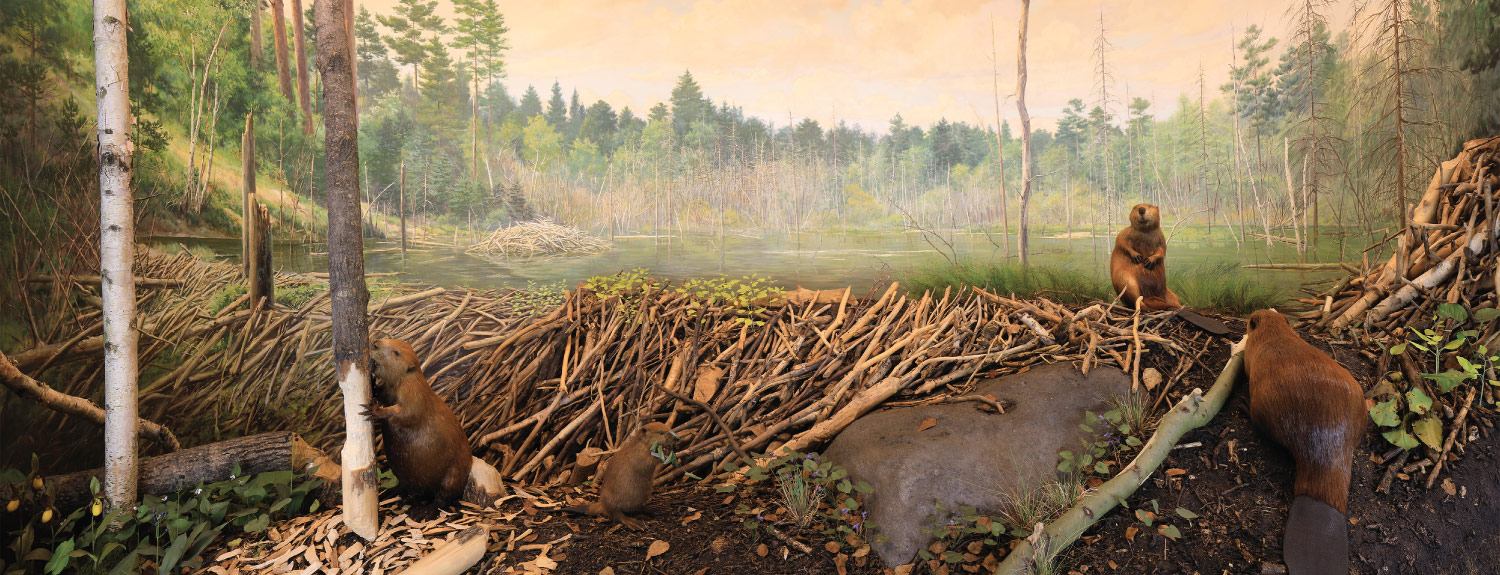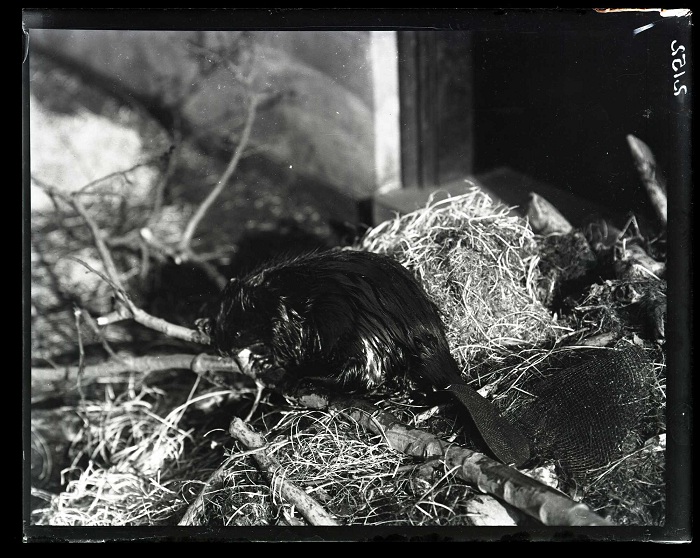Beavers have had ups and downs. When Itasca State Park opened in 1891, trapping had eliminated beavers from Minnesota. They were reintroduced in 1901 and by 1919, when this diorama was created, beavers were flourishing at Itasca. Today, beavers continue to thrive across Minnesota. And Itasca State Park—Minnesota’s oldest—preserves one of the last remaining stands of old growth pines in the state, visible here, on the hillside.
Beavers are among nature’s best architects and engineers. Their dams transform flowing forest streams into ponds and wetlands, giving these excellent swimmers easy access to food. Ponds also serve as moats protecting beavers from wolves, coyotes, and lynx. The beavers here are a family group with an adult pair and their young. At age three, young beavers set off to build their own dam and lodge from logs, branches, and mud.
Notes on a scene
Beavers make a good subject for a diorama because as a “home builder” many aspects of their life history can be displayed in a small space. The beaver dam, pond and lodge are all shown. The beaver are cutting aspen – their favorite food – and their social structure is on display with animals of different age and size: a mated pair with their nearly full grown two-year-old young and small kits. Around the corner is a window to view into the interior beaver lodge—a diorama innovation at the time.
Charles Corwin, one of the foremost diorama painters of his day, visited this site in Itasca State Park and made many sketches and small paintings in preparation for the background painting. Apparently, he had the painting well worked out in his mind, he painted from the left to the right and when he reached the right edge, the painting was complete.
Move and restoration
The “Beavers at Lake Itasca” diorama is the oldest of the large dioramas at the Bell Museum. It has been moved twice in it’s 100 year history, and this most recent move presented an opportunity to restore the diorama to its original artistry.
 In the 1940s move, the background painting was retouched with a brown color to better match the new glycerin gel “water” made for the pond in the foreground. The water needed to be recreated again in the 2017-18 move, but this time it was made using resin which allowed for a more realistic simulation of moving water. Visitors will notice a new ripple behind the beaver swimming across the pond, which was previously a flat, still surface. Both the water and painting were also restored to their original greenish hue.
In the 1940s move, the background painting was retouched with a brown color to better match the new glycerin gel “water” made for the pond in the foreground. The water needed to be recreated again in the 2017-18 move, but this time it was made using resin which allowed for a more realistic simulation of moving water. Visitors will notice a new ripple behind the beaver swimming across the pond, which was previously a flat, still surface. Both the water and painting were also restored to their original greenish hue.
Other changes made in the 2017-2018 restoration of the dioramas include: anti-reflective glass, an array of LED lights (no more damage from the UV light of fluorescent bulbs or heat-producing incandescent bulbs), cleaning of the background painting and all plants and animal artifacts. Taxidermy, for example, naturally degrades over time, and to varying degrees, depending on when and how it was prepared. Right: one of the beavers from the Bell’s diorama before (top) and after (bottom) restoration.
Diorama Quick Facts
Location: A stream that feeds into Lake Itasca in Itasca State Park, Clearwater County
Biome location: transition zone between the north woods & prairie grasslands
Date depicted: June 1919
Date completed: April 1919
Dimensions: 10’ x 20’
Background Artist: Charles Corwin
Foreground Artist: Mr. and Mrs. Jenness Richardson
Donors: The Friends of Thomas Sadler Roberts (founding), Diorama Legacy Society (2018). This diorama is part of the North Woods Biome, made possible by Jerome & Patricia Hartlaub.
Restoration Team (2017-18): Midwest Art Conservation Center, Chase Studios, Museum Professionals, Split Rock Studios

Move bar to see the meticulously restored diorama on the right Turn device to landscape orientation to view the full diorama
Beavers at Lake Itasca
This graphic shows the appearance of the diorama before and after restoration.
Horatio and Ignatius
In 2012, the Hennepin County and University of Minnesota Libraries were awarded a Minnesota Arts and Cultural Heritage Fund grant for Exploring Minnesota’s Natural History, a 12 month project to digitize archival records of early investigations into the flora, fauna, geology, and natural environment of the state of Minnesota. The digitized materials included 6,500 glass plate and film negatives, 2,200 photographic prints, 3,200 lantern slides, over 170,000 pages of archival material (journals, correspondence, scrapbooks, departmental reports, and publications).
After describing metadata for over 2,000 scanned images of the glass plate negatives from the museum’s collection, U archivist Rebecca Toov came across something wonderful: evidence of Ignatius and Horatio, the two live beavers once housed in a pool at the University’s Zoological Museum/Museum of Natural History (now Bell Museum).


The beavers were presented to the museum as kits in 1917 by Mr. Carlos Avery. The beavers, named Ignatius Pzermysl Beaver and Horatio William Beaver, lived in a pond outside of the Animal Biology Building (razed in 1994, at the current site of Hasselmo Hall), until their ultimate disappearance (Beaver 1, 1921), and passing (Beaver 2, 1924). In a letter to James Ford Bell dated September 19, 1917, in which he discussed diorama preparations, Dr. Thomas Sadler Roberts, Associate Curator, included a post script:
“Have two live young beaver in an outside pool here at the U. Have much amusement watching them. They are making effort in part at house building! Wish you could see them.”
Read more about these furry friends and the rest of the fascinating discoveries made during the Exploring Minnesota digitization project at z.umn.edu/naturalhistorymn.
Celebrate!
International Beaver Day is recognized annually on April 7. Help spread the word about the world’s second largest rodent species (after the capybara)! Learn more about their habitat and behavior online, dive deeper to learn about its prehistoric relative Castoroides—also on view at the Bell, hike to a beaver pond, or find a cool video like the one below to share with friends.
This video was made by the Voyageurs Wolf Project, an active research project supported in part by the Bell Museum:

